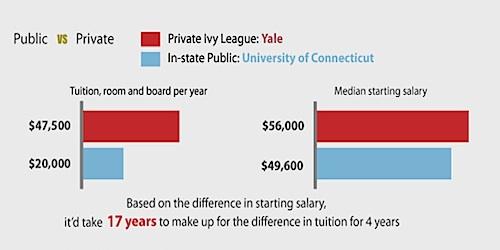Cost of Public vs. Private Schools
Karen Young
Mr. Reuter
Economics
9 February 2014
Cost of Public versus Private Universities
With an even more competitive job market after the 2009 recession, many students are recognizing the value of a post-secondary education in order to boost their value to possible employers. The difficulty in the decision lies not in the choice to attend college, but rather the choice between attending a private or public university. Although all students hope to attend their dream college, the scarcity of money often impacts their decision on which school they will attend.
People traditionally expect private universities to be more expensive than public colleges, because the private schools do not receive state aid. Also, the more selective universities have historically been more expensive than less selective schools, with a high percentage of the selective universities being private schools. Therefore, the public often correlates expensive tuition with private schools. With varying levels of scholarships and financial aid, however, the cost of a private university can equal or be less than that of a public college. Gary Hoffman explains how being a competitive and talented student can severely lower the cost of a private school in this video:
Due to the high percentage of “gift aid” given at private colleges, the expense will decrease drastically for those very qualified students. Gift aid represents money given to a student by a college that they will never need to pay back. For others who do not qualify for the same financial aid, private universities remain significantly more expensive than public universities – for a student who hopes to attend a private university, the opportunity cost of attending a public school for much less money may seem very appealing. According to Mandi Woodruff of Business Insider, “Tuition and fees for a public four-year institution cost $20,823 for the 2011-12 school year –– about $8,000 less than private institutions” (Woodruff). By offering a quality education for much less money, the public colleges decrease the marginal cost of postsecondary education without decreasing the marginal benefit. Although the class sizes might be a little bit bigger, for many students, public schools carry the best advantages. 
If public schools offer cheaper tuition for a very similar education, how do private schools attract any students at all? In the New York Times article, Getting Out of Discount Game, Small Colleges Lower the Price, David Warren offers an insightful comment: “Schools wanted a high tuition on the assumption that families would say that if they’re charging that high tuition, they must be right up there with the Ivies… so schools would set a high tuition, then discount it” (Lewin). By attending a private university, many students believe that they are increasing their human capitol by a larger amount than had they attended a public university; they hope that in leaving college with greater human capitol, they will seem more attractive to potential employers, and therefore have more stability in the job market. As seen in the image above, Yale University was a more expensive institution than the public University of Connecticut, but Yale graduates had higher paying jobs after college that would help to repay the loans of school. When weighing the marginal benefit of a private school against the marginal cost, one must look into the future in order to gain a realistic view of money gained by attending a private college.
The decision to attend a private or public college differs for every person, depending on their family, financial status, and personal values. Although private colleges have been historically more expensive, “many private colleges are rethinking their pricing – whether cutting or freezing tuition, or locking in the freshman tuition for all four years” (Lewin). A student should research all of the academic and social opportunities at both private and public colleges and then look into financial aid and scholarships in order to pay for the colleges. As we approach the end of our senior year, it is important that we compare our options for next year. Both public and private universities offer unique advantages; it is up to us to look at the marginal benefit and marginal cost of our decision and compare it to that of the opportunity cost so that we can choose the college that will help the us grow and mature into the best citizen we can be.
Works Cited:
Jacobs, Deborah L. "Public Or Private College. Is The Outcome Any Different?" Forbes. Forbes Magazine, 02 Oct. 2013. Web. 1 Feb. 2014.
Lane, Finn. Public Versus Private College Cost. Digital image. The Digerati Life RSS. June Tree, 23 Dec. 2009. Web. 01 Feb. 2014.
Lewin, Tamar. "Getting Out of Discount Game, Small Colleges Lower the Price." The New York Times. The New York Times Company, 25 Dec. 2013. Web. 1 Feb. 2014.
Public vs. Private Schools: Real Cost May Surprise You. Dir. Gary Hoffman. Perf. Gary Hoffman. YouTube. YouTube, 25 Mar. 2012. Web. 01 Feb. 2014.
Woodruff, Mandi. "Public Vs. Private College: Which Is Better for Your Wallet?" Business Insider. Business Insider, Inc., 22 May 2013. Web. 1 Feb. 2014.
0 Response to "Cost of Public vs. Private Schools"
Post a Comment